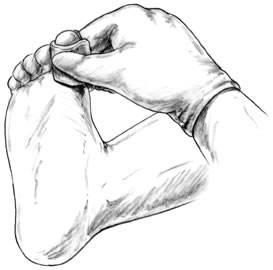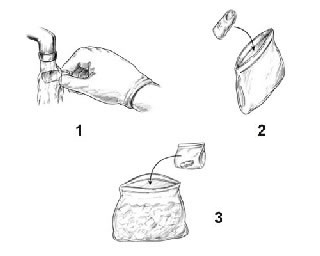Toe Injury
Is this your child’s symptom?
- Injuries to toes
Types of Toe Injuries
- Cuts, Scrapes and Bruises. These are the most common injuries.
- Jammed Toe. The end of a straightened toe receives a blow. This is usually from stubbing the toe on an object. The energy is absorbed by the joint surface and the injury occurs there. This is called traumatic arthritis.
- Crushed or Smashed Toe. This is usually from something heavy falling on the toe. Sometimes, the nail can be damaged. Fractures are unusual, but are at risk for a bone infection (osteomyelitis).
- Toenail Injury. If the nailbed is cut, it may need sutures to prevent a permanently deformed nail. This is less important for toenails.
- Subungual Hematoma (Blood Clot under the Nail). Most often caused by a crush injury. It can be from a heavy object falling on the nailbed. Many are only mildly painful. Some are severely painful and throbbing. These need the pressure under the nail released. A doctor can put a small hole through the nail to release the blood. This can relieve the pain and prevent loss of the nail.
- Dislocations. The toe has been pushed out of its joint.
- Fractures. Toe has a broken bone. The treatment is the same whether the toe is broken or just bruised. Broken toes are not put in a cast.
Concerns About Missing a Broken Toe
- Most swollen, bruised and painful toes are not broken.
- X-rays are only needed for severe pain and severe injuries.
- If the big toe might be broken, it should be seen by a doctor. The other injured toes generally don’t need to be seen.
- A broken great toe is not urgent. It can be checked during office hours.
- The treatment is the same whether or not the toe is broken.
- The treatment of all broken toes is pain medicine and comfortable footwear.
Pain Scale
- Mild: Your child feels pain and tells you about it. But, the pain does not keep your child from any normal activities. School, play and sleep are not changed.
- Moderate: The pain keeps your child from doing some normal activities. It may wake him or her up from sleep.
- Severe: The pain is very bad. It keeps your child from doing all normal activities.
When to Call for Toe Injury
Call Doctor or Seek Care Now
|
Call Doctor Within 24 Hours
Call Doctor During Office Hours
|
Self Care at Home
|
Call Doctor or Seek Care Now
- Skin is split open or gaping and may need stitches
- Large swelling is present
- Blood under a nail is causing more than mild pain
- Nail is torn
- Base of nail has popped out from under the skin fold
- Dirt in the wound is not gone after 15 minutes of scrubbing
- Severe pain and not better 2 hours after taking pain medicine
- Age less than 1 year old
- Age less than 2 years and toe tourniquet suspected. (Hair wrapped around toe, groove, swollen red or bluish toe)
- You think your child has a serious injury
- You think your child needs to be seen, and the problem is urgent
Call Doctor Within 24 Hours
- Broken toe suspected
- Toe injury that causes bad limp
- You think your child needs to be seen, but the problem is not urgent
Call Doctor During Office Hours
- Dirty cut and no tetanus shot in more than 5 years
- Clean cut and no tetanus shot in more than 10 years
- Pain not better after 3 days
- Not using the toe normally after 2 weeks
- You have other questions or concerns
Self Care at Home
- Minor toe injury
Care Advice for Minor Toe Injuries
-
What You Should Know About Toe Injuries:
- There are many ways that children can hurt their toes.
- There are also many types of toe injuries.
- You can treat minor toe injuries at home.
- Here is some care advice that should help.
-
Pain Medicine:
- To help with the pain, give an acetaminophen product (such as Tylenol).
- Another choice is an ibuprofen product (such as Advil).
- Use as needed.
-
Bruised/Swollen Toe:
- Soak in cold water for 20 minutes.
- Repeat as needed.
-
Small Cuts or Scratches:
- For any bleeding, put direct pressure on the wound. Use a gauze pad or clean cloth. Press down firmly on the place that is bleeding for 10 minutes. This is the best way to stop bleeding. Keep using pressure until the bleeding stops.
- Wash the wound with soap and water for 5 minutes.
- For any dirt in the wound, scrub gently.
- For any cuts, use an antibiotic ointment (such as Polysporin). No prescription is needed.
- Cover it with a bandage (such as Band-Aid). Change daily.
-
Jammed Toe:
- Caution: Be certain range of motion is normal. Your child should be able to bend and straighten each toe. If movement is limited, your doctor must check for a broken bone.
- Soak the foot in cold water for 20 minutes.
- If the pain is more than mild, “buddy-tape” it to the next toe.
-
Smashed or Crushed Toe:
- Wash the toe with soap and water for 5 minutes.
- For any cuts, use an antibiotic ointment (such as Polysporin). No prescription is needed.
- Cover it with a bandage (such as Band-Aid). Change daily.
-
Torn Nail (from catching it on something):
- For a cracked nail without rough edges, leave it alone.
- For a large flap of nail that’s almost torn through, cut it off. Use a pair of scissors that have been cleaned. Cut along the line of the tear. Reason: Pieces of nail taped in place will catch on objects.
- Soak the toe for 20 minutes in cold water for pain relief.
- Use an antibiotic ointment (such as Polysporin). No prescription is needed. Then cover with a bandage (such as Band-Aid). Change daily.
- After about 7 days, the nailbed should be covered by new skin. It should no longer hurt. A new nail will grow in over 6 to 8 weeks.
-
Shoes to Reduce Pain:
- If regular shoes cause too much pain, make a change in footwear.
- Wear a shoe with a firm sole to limit motion. Reason: Injured toes hurt when they bend (are flexed).
- If the top of the shoe increases pain, wear an open-toe sandal. Another option is to use an old sneaker. Then cut out the part over the toe.
-
Buddy-taping:
- Buddy-taping is taping the injured toe to the one next to it.
- Method: Gauze padding must be placed between the toes before taping them together.
- How long to buddy tape: Usually needed for 1 – 2 weeks. By then new bone formation will close the break. Then pain with movement will be reduced.
- Usefulness: Buddy-taping is optional. Sometimes, it makes the pain worse. Wearing the right shoe is much more helpful.
-
Call Your Doctor If:
- Pain becomes severe
- Pain not better after 3 days
- Toe not normal after 2 weeks
- You think your child needs to be seen
- Your child becomes worse
And remember, contact your doctor if your child develops any of the ‘Call Your Doctor’ symptoms.
Disclaimer: this health information is for educational purposes only. You, the reader, assume full responsibility for how you choose to use it.
Copyright 2000-2019 Schmitt Pediatric Guidelines LLC.




